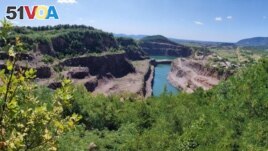13 March 2024
Researchers say they have identified stone tools that might represent the oldest-known evidence of humans in Europe.
The recent research suggests that the human ancestors started settling Europe 1.4 million years ago. That is hundreds of thousands of years earlier than previously thought.
The stone tools were first discovered in the 1970s near the town of Korolevo, close to Ukraine's borders with Hungary and Romania. But the tools' age had remained unclear.

FILE - A view of the Korolevo quarry in western Ukraine, surrounded by archaeological sites, August 12, 2021. (Roman Garba/Handout via REUTERS)
The place of the find is important for understanding how humans first spread into Europe. They moved into the area during warm periods, called interglacial periods. Those were times, in between Ice Ages, when huge amounts of ice covered Europe.
The scientists used a method for estimating the age that identifies the effects of cosmic rays on some kinds of minerals. The new method placed the age of the sediment layer containing the stone tools at around 1.4 million years.
The researchers believe that the maker of the tools was likely a human ancestor called Homo erectus. That early human species appeared around 2 million years ago and spread across Africa, Asia and Europe before disappearing perhaps 110,000 years ago.
"No bones were found at Korolevo, only stone tools. But the age suggests that Homo erectus was the only possible human species at the time. We know very little about our earliest ancestors. They used stone tools for butchery and probably used fire," said Roman Garba of the Czech Academy of Sciences. Garba was the lead writer of the research published in Nature.
Homo erectus was the first member of our evolutionary lineage. Homo erectus had body proportions like our species, Homo sapiens, though with a smaller brain.
The tools, made of volcanic rock, were made in a way that is called Oldowan. While simple, they represent the beginning of human technology.
Until now, the oldest-known evidence of humans in Europe was from about 1.2 million years ago from a place called Atapuerca in Spain.
The Korolevo findings suggest how the first humans might have moved into Europe. Homo erectus fossils from 1.8 million years ago are known from a place in the Caucasus Mountains in Georgia called Dmanisi. Garba said the evidence from Korolevo and Dmanisi suggests Homo erectus entered Europe from the east or southeast, moving along the Danube River.
It has been difficult to identify the age of places like Korolevo. The study dated the tools, left by their makers on a riverbed, by estimating when the layer holding the objects was buried under sediment.
Mads Knudsen of Aarhus University in Denmark described how scientists were able to date the prehistoric tools.
He said cosmic rays from outer space are always passing through the Earth's atmosphere. When they do, they create particles that are smaller than atoms, such as neutrons and muons. These particles are so small that they pass through all sorts of materials.
These particles react with minerals in rocks to produce radioactive nuclides, a class of atoms. The sediment was dated based on the ratio of two nuclides. This is possible because the two nuclides break down at different rates, through the process of radioactive decay.
Europe was later colonized by other human ancestor species including Homo heidelbergensis and Neanderthals. Scientists say Homo sapiens evolved in Africa about 300,000 years ago. They arrived in large numbers in Europe around 40,000 to 45,000 years ago.
The researchers suspect evidence of human occupation in Europe that is even older than Korolevo will be found.
"The question is not 'if' but 'when' we will find a site of similar or older age somewhere else in Ukraine, Romania, Bulgaria or Serbia," Garba said.
I'm John Russell.
Will Dunham reported on this story for Reuters. John Russell adapted it for VOA Learning English.
______________________________________________
Words in This Story
cosmic rays – n. particles of atomic or smaller size that pass into the Earth's atmosphere from space at extremely high energy levels
sediment – n. material (such as stones and sand) that sinks to the bottom of a body of water forming a layer that solidifies into rock over long periods of time
species –n. a group of animals or plants that are similar and can produce young
butchery – n. the job or act of preparing meat for eating
lineage – n. the people who were in someone's family in past times
proportion – n. the relationship between the size, shape, and position of the different parts of something
fossil – n. something (such as a bone or footprint) that is from a plant or animal that lived in ancient times
ratio –n. a numerical relationship between two values